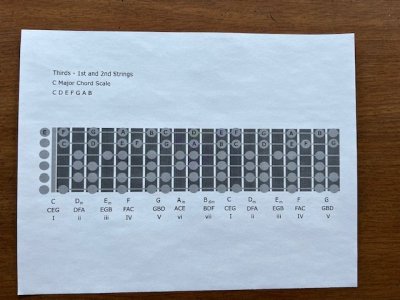bryarblue72
Newbie
- Messages
- 7
Hello all:
I am mostly a beginner and have been learning pentatonic, diatonic scales and the like. I heard about using 3rds, 6ths, etc., in music so I started to work out what I *think* is right on the fretboard using the C Major scale.
I started by overlaying the notes of the C Major scale on the fretboard and then using intervals of 3rds I mapped out the 1st and 2nd strings. Interestingly the note pairs match the 1 and 3 notes of the chord triads shown in the C Major Chord scale (I inserted the associated Chord at the bottom at the centerline between the notes and also noted the 1,3,5 notes of the triad.
Two questions:
1. Am I even remotely right in what I have laid out for the 3rds for the first two strings? I.e., is my logic correct?
2. If I play these pairs of thirds notes along with a backing track in C Major playing the correct pair with the actual chord being played on the backing track, of course they sound like they go with it but is that really what you are doing with these thirds?
Thank you in advance!

I am mostly a beginner and have been learning pentatonic, diatonic scales and the like. I heard about using 3rds, 6ths, etc., in music so I started to work out what I *think* is right on the fretboard using the C Major scale.
I started by overlaying the notes of the C Major scale on the fretboard and then using intervals of 3rds I mapped out the 1st and 2nd strings. Interestingly the note pairs match the 1 and 3 notes of the chord triads shown in the C Major Chord scale (I inserted the associated Chord at the bottom at the centerline between the notes and also noted the 1,3,5 notes of the triad.
Two questions:
1. Am I even remotely right in what I have laid out for the 3rds for the first two strings? I.e., is my logic correct?
2. If I play these pairs of thirds notes along with a backing track in C Major playing the correct pair with the actual chord being played on the backing track, of course they sound like they go with it but is that really what you are doing with these thirds?
Thank you in advance!

